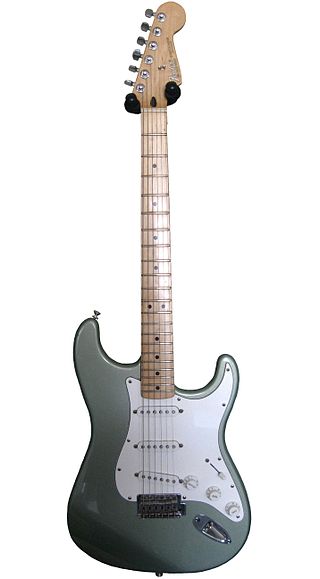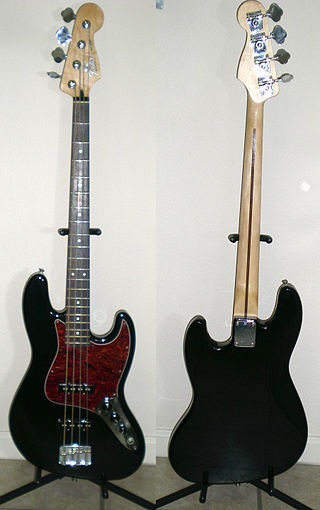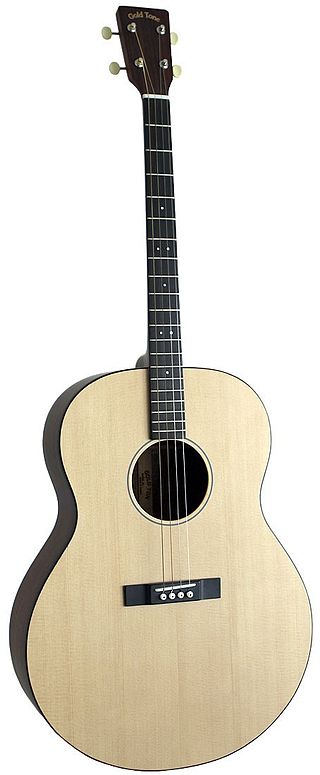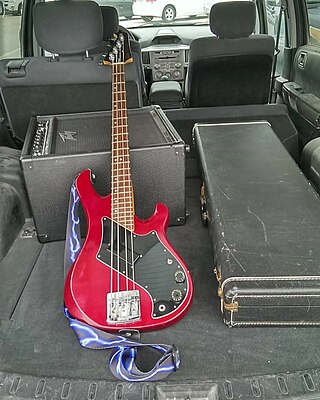
The bass guitar, electric bass or simply bass, is the lowest-pitched member of the guitar family. It is a plucked string instrument similar in appearance and construction to an electric or acoustic guitar, but with a longer neck and scale length, and typically four to six strings or courses. Since the mid-1950s, the bass guitar has largely replaced the double bass in popular music.

Clarence Leonidas Fender was an American inventor known for founding the Fender Musical Instruments Corporation and designing the company's early models, the Fender Telecaster, Fender Precision Bass, and Fender Stratocaster. In January 1965, he sold Fender to CBS, and later founded two other musical instrument companies, Music Man and G&L Musical Instruments.

The Fender Stratocaster, colloquially known as the Strat, is a model of electric guitar designed between 1952 and 1954 by Leo Fender, Bill Carson, George Fullerton, and Freddie Tavares. The Fender Musical Instruments Corporation has continuously manufactured the Stratocaster since 1954. It is a double-cutaway guitar, with an extended top "horn" shape for balance. Along with the Gibson Les Paul, Gibson SG, and Fender Telecaster, it is one of the most-often emulated electric guitar shapes. "Stratocaster" and "Strat" are trademark terms belonging to Fender. Guitars that duplicate the Stratocaster by other manufacturers are sometimes called S-Type or ST-type guitars.

A single coil pickup is a type of magnetic transducer, or pickup, for the electric guitar and the electric bass. It electromagnetically converts the vibration of the strings to an electric signal. Single coil pickups are one of the two most popular designs, along with dual-coil or "humbucking" pickups.

Hunter Benedict Shepherd is an American musician best known as the bassist of rock band Soundgarden. Shepherd has won two Grammy Awards as a member of Soundgarden.

The Gibson EDS-1275 is a doubleneck Gibson electric guitar introduced in 1963 and still in production. Popularized and raised to iconic status by musicians such as John McLaughlin and Jimmy Page, it was called "the coolest guitar in rock."

The Fender Precision Bass is a model of electric bass guitar manufactured by Fender Musical Instruments Corporation. In its standard, post-1957 configuration, the Precision Bass is a solid body, four-stringed instrument usually equipped with a single split-coil humbucking pickup and a one-piece, 20-fret maple neck with rosewood or maple fingerboard.

The Fender Jazz Bass is the second model of electric bass created by Leo Fender. It is distinct from the Precision Bass in that its tone is brighter and richer in the midrange and treble with less emphasis on the fundamental frequency. The body shape is also different from the Precision Bass, in that the Precision Bass has a symmetrical lower bout on the body, designed after the Telecaster and Stratocaster lines of guitars, while the Jazz Bass has an offset lower bout, mimicking the design aesthetic of the Jaguar and Jazzmaster guitars.

The baritone guitar is a guitar with a longer scale length, typically a larger body, and heavier internal bracing, so it can be tuned to a lower pitch. Gretsch, Fender, Gibson, Ibanez, ESP Guitars, PRS Guitars, Music Man, Danelectro, Schecter, Jerry Jones Guitars, Burns London and many other companies have produced electric baritone guitars since the 1960s, although always in small numbers due to low popularity. Tacoma, Santa Cruz, Taylor, Martin, Alvarez Guitars and others have made acoustic baritone guitars.

Joseph Daniel Principe is an American musician. He is the bassist, backing vocalist, and co-founder of the punk rock band Rise Against.

The tenor guitar or four-string guitar is a slightly smaller, four-string relative of the steel-string acoustic guitar or electric guitar. The instrument was initially developed in its acoustic form by Gibson and C.F. Martin so that players of the four-string tenor banjo could double on guitar.

The Gibson Moderne is an electric guitar model prototyped by Gibson in 1957. It was designed alongside the Flying V and Explorer-"Futura" as part of a stylistically advanced line of electric guitars. However, unlike the Flying V and Explorer, the Moderne was not put into production until 1982.
The Fender Mustang Bass is an electric bass guitar model produced by Fender and Squier. Two variants, the Musicmaster Bass and the Bronco Bass, have also been produced from time to time using the same body and neck shape.
Lakland Guitars is an American manufacturer of electric bass guitars based in Chicago, Illinois. The company's first bass combined elements of the Fender Jazz Bass and the Music Man StingRay. The company's current line-up includes basses inspired by classics like the Fender Precision Bass and Jazz Bass as well as Lakland's own original designs. Lakland's line of signature models includes basses designed in collaboration with well-known bassists Joe Osborn, Donald "Duck" Dunn, Jerry Scheff, Darryl Jones and Bob Glaub. Lakland basses are manufactured in the United States and Indonesia.
The Fender Prophecy II Bass was a Japanese-made, limited-edition bass guitar which was a significant departure from the well-known traditional Precision Bass and Jazz Bass. It was actually produced by Heartfield in Japan's Fujigen Gakki factory.
The Fender Telecaster, colloquially known as the Tele, is an electric guitar produced by Fender. Together with its sister model the Esquire, it was the world's first mass-produced, commercially successful solid-body electric guitar. Its simple yet effective design and revolutionary sound broke ground and set trends in electric guitar manufacturing and popular music.
The EchoSonic is a guitar amplifier made by Ray Butts. It was the first portable guitar amplifier with a built-in tape echo effect, and it allowed guitar players to use slapback echo, which dominated 1950s rock and roll guitar playing, on stage. He built the first one in 1953 and sold the second one to Chet Atkins in 1954. He built fewer than seventy of those amplifiers; one of them was bought by Sam Phillips and then used by Scotty Moore on every recording he made with Elvis Presley, from the 1955 hit song "Mystery Train" to the 1968 TV program Comeback Special. Deke Dickerson called the amplifier the Holy Grail of rockabilly music.

Vintage musical equipment is older music gear, including instruments, amplifiers and speakers, sound recording equipment and effects pedals, sought after, maintained and used by record producers, audio engineers and musicians who are interested in historical music genres. While any piece of equipment of sufficient age can be considered vintage, in the 2010s the term is typically applied to instruments and gear from the 1970s and earlier. Guitars, amps, pedals, electric keyboards, sound recording equipment from the 1950s to 1970s are particularly sought. Musical equipment from the 1940s and prior eras is often expensive, and sought out mainly by museums or collectors.

The Gibson Victory Bass was an electric bass guitar produced by Gibson Guitars from 1981 until 1986. It was a bass guitar variant of the Gibson Victory. It was not a successful model.
















